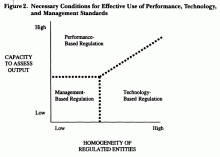There are two major themes in my research on regulation. The first is around domestic regulation, focusing on an emerging regulatory approach that Cary Coglianese and I have labeled "management-based regulation" (MBR). MBR is an intervention at the management level, rather than output or technology level, and has really become quite widespread in the last 15 years, as command and control has hit its limits in a variety of domains. Our papers provide an exploration of the defining features of this regulatory tool, and point to underlying conditions (e.g., heterogeneity of regulated sites, and high costs of measurement) under which MBR might be a desirable regulatory model.
In the second theme of my research on regulation, I look at the types of regulatory interdependence that exist in the international system. In particular, I have argued that there are three modes of regulatory policy interdependence: competitive, coordinative, and informational. In the competitive mode, states use regulatory policy to differentiate themselves in competition with other states—e.g., for international capital. In the coordinative mode, states benefit by having the same standards as other states—e.g., to maintain access to foreign markets. Finally, in the informational mode, states are informationally interdependent, where the experiences of one country provide lessons for others.
